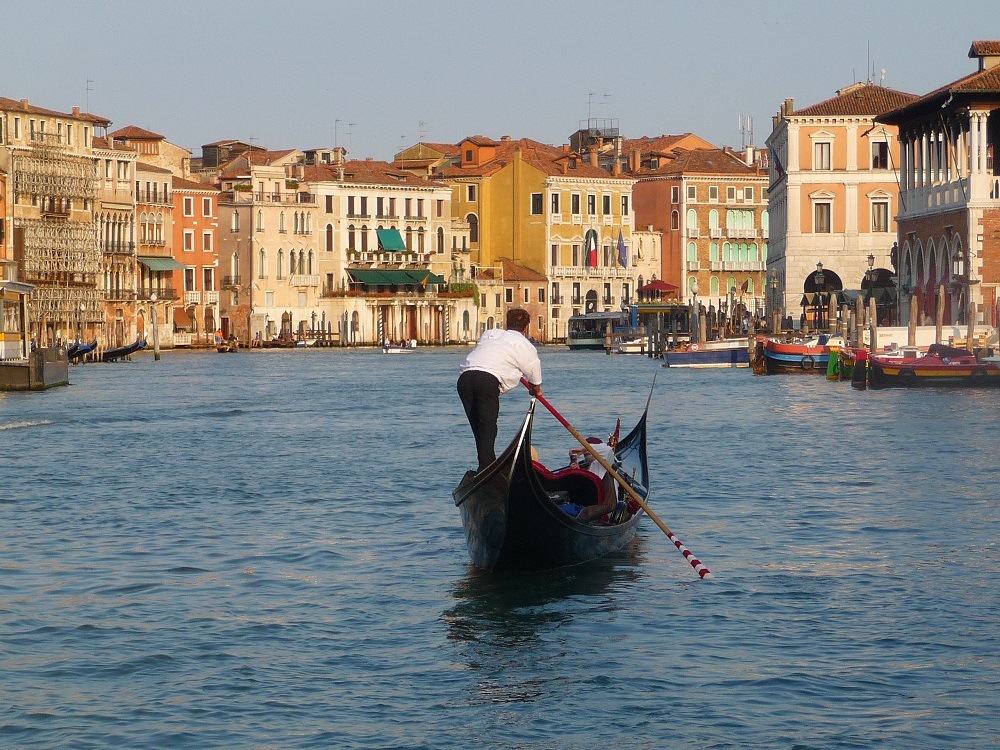
We are pleased to present two more recordings from our initial sight-reading session of selection from Ten Italian Renaissance Duets published by Cherry Classics and recorded by Duo Brass featuring Morgen Low on trumpet and David Brubeck on bass trombone. These are important reference recordings for what appears to be the origins of a the most significant body of mixed-brass duo literature.
THE MYSTERY OF THE TOP PART The range for the top voice is curiously limited to an octave or less-(‘E’ to ‘E’; from the bottom line to the top space of the treble clef in ‘C’!) Of the most common soprano instruments recorded in use at the Orthodox Christian Basilica of St. Mark’s in Venice or ‘La Serenissima’. the treble viol would have been nearly impossible due to it’s insufficient upper range. The violin would have been most unlikely to have been written with a tessitura so restricted as we find of less than an octave; much less in that particular register! Similarly, with nearly a two-octave range, the soprano recorder would not be a likely candidate for melodies most often using less than half it’s range-(whether in it’s cylindrical or later conical iteration). The Renaissance soprano trombone was a fiction, and only assumed to exist and having been drawn from the imagination based on that assumption.

THE MYSTERY OF THE BOTTOM PART While the tenor cornett (or cornetto), was cited as something used for alto and tenor function, it’s range typically extends only to the ‘C’ an octave below middle ‘C’. That would leave a deficiency in range of an entire 5th for the bottom duo part, which frequently reflects a more bass-type function. The bottom part is commonly written as low as the ‘F’ just below the bass clef staff. In 6th position, this would be comfortably accessible by a tenor trombone and trombonist of the day. here are no indications of notes lower than this ‘F’, so there is no reason to believe the instrument was bass trombone, in addition to the fact that the parts venture up to ‘G’ and perhaps even ‘A’ above middle ‘C’, which are almost completely unlikely on the Renaissance bass trombone or bass viol, while still within the reach of the Renaissance tenor trombone.
There does not seem to be a likelyhood that cello was employed, and had it been, one could have easily encountered pitches up to a fourth lower than present. The range present in these duos does find another mirror in the range of the tenor Viol, but the tone of a tenor viol would likely be insufficient to provide equal balance to even a violin, much less a cornetto. Tenor Trombone seems to be the only likely instrument available with the correct range and musical presence for the bottom of the duo parts.

In Vivaldi’s Venice, author Patrick Barbier cites a registry from St. Mark’s in 1708 AD that provides a first-hand account of the instrumentation available at that time: “Indicates the presence of 23 musicians engaged for life and divided as follows: 10 violins (including the father of Antonio Vivaldi), three small violas, one viola de braccia (a sort of alto), one violine (close to a double bass), three theorbos, one cornett, one oboe, two trumpets and one trombone.”
A hundred years earlier, the famous 1597 AD “Sonata piano e forte” by Giovanni Gabrieli, specified eight musicians: 6 trombones, 1 cornett/cornetto, and 1 viol. The piece was historic for its early written use of dynamics and specific instrumentation. It features two choirs in antiphony. One comprised of cornetto and 3 trombones, the other was comprised of one viol and three trombones.
A CHRISTIAN OUTPOST La Serenissima (or Venice), was founded by Christians who were shown the sparkling lights on its lagoon after intense prayer and near-starvation. Venice began its life as a city dedicated to God by its Christian founders.
The text of Psalm 117 is implied by these first words of one duo in Latin:
“Praise the Lord, all nations!
Extol him, all peoples!
2 For great is his steadfast love toward us,
and the faithfulness of the Lord endures forever.
Praise the Lord!”
from esv.org
FEATURED DUO BRASS RECORDING: 6. Omnes gentes
The accounts of the great musicality of Venice at the time included the commonplace singing of fishermen as they returned home to their wives who awaited them on the docks, and the tradition of the gondoliers singing together to train the younger members of their trade. Of great importance was the impressive series of musical orphanages set up throughout the city. The intense musicality of Venice at the time led to one visiting nobleman to remark in a report to his home and that he could assemble an orchestra from the beggars in La Serenissima (Venice), better than almost any one found in European courts.
The loving and at times erotifc metaphors found in the Bible in the Song of Solomon describe his wedding to his black African wife. God’s provision of the joy of love and sex in the context of marriage may seem incongruous next to other Biblical texts to some. In parallel fashion, the sacred plaza of St. Mark’s in the 1600’s embraced the near-constant joys of the carnivals of Venice. These carnivals ran almost constantly throughout the year and celebrated life and music. Interestingly, the carnivals of Venice became a deterrent to invaders, to whom they gave the impression that the city was too populous to invade-unaware that many of the throngs were fellow tourists.

SONG OF SOLOMON
2 I am the rose of Sharon, and the lily of the valleys.
2 As the lily among thorns, so is my love among the daughters.
3 As the apple tree among the trees of the wood, so is my beloved among the sons. I sat down under his shadow with great delight, and his fruit was sweet to my taste.
4 He brought me to the banqueting house, and his banner over me was love.
5 Stay me with flagons, comfort me with apples: for I am sick of love.
12 A garden inclosed is my sister, my spouse; a spring shut up, a fountain sealed.
15 A fountain of gardens, a well of living waters, and streams from Lebanon.
from www.biblegateway.com
FEATURED DUO BRASS RECORDING: 3. Ego flos campi

Venice was really an ORTHODOX CHRISTIAN satellite of Constantinople, and not Catholic Rome. Equally, it might be argued by some, that Venice is as much a continuation of the ANCIENT World established by Rome and carried by CONSTANTINOPLE into what Europeans considered “The Renaissance”.
Indeed, some have argued that the fall of Constantinople in 1453 AD was THE reason for the Western European Renaissance, as the Greek Scholars fled the Constantinople, which had been known for more than a MILLENIUM as the eye of the world, to new patrons and protectors in Europe.
CHECK OUT THE FIRST DUOS FROM THIS COLLECTION RECORDED HERE:
c. 2024 David William Brubeck All rights Reserved
image courtesy of www.mattathimeinthe world.com
COPYRIGHT NOTICE/DISCLAIMER
FAIR USE:
COPYRIGHT DISCLAIMER UNDER SECTION 107 OF THE COPYRIGHT ACT 1976,
ALLOWANCE IS MADE FOR “FAIR USE” FOR PURPOSES SUCH AS CRITICISM, COMMENT, NEWS REPORTING, TEACHING, SCHOLARSHIP AND RESEARCH.
FAIR USE IS PERMITTED BY COPYRIGHT STATUTE THAT MIGHT OTHERWISE BE INFRINGING. NON-PROFIT, EDUCATIONAL OR PERSONAL USE TIPS THE BALANCE IN FAIVOR OF FAIR USE
PS
Is it EVEN POSSIBLE that trombones could REALLY be the founding instrument of the symphony orchestra? While it is true that trombones comprised nearly 70% of what may arguably be the first symphonic composition-the “Sonata piano e forte”, perhaps a bit more investigation is warranted.
Please consider spending fifteen minutes to hear how full the sound of just three trombones can be in the YouTube video of the Chicago Symphony Orchestra Trombone trio below. They are quite nearly the equivalent of three ENTIRE string sections: viola, ‘cello and bass.
All that is needed is a soprano instrument like the cornet or trumpet, violin or viol…..or two! (Okay, or a soprano recorder!)
